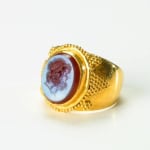Classical Revival Intaglio of an Emperor or Deity, 1700 CE - 1800 CE
Sardonyx-Gold
FJ.6370
Further images
This Intaglio is Set in an 18 Karat Gold Rin The art of glyptics, or carving on colored precious stones, is probably one of the oldest known to humanity. Intaglios,...
This Intaglio is Set in an 18 Karat Gold Rin
The art of glyptics, or carving on colored precious stones, is probably one of the oldest known to humanity. Intaglios, gems with an incised design, were made as early as the fourth and third millennia BC in Mesopotamia and the Aegean Islands. They display a virtuosity of execution that suggests an old and stable tradition rooted in the earliest centuries. The tools required for carving gems were simple: a wheel with a belt-drive and a set of drills. Abrasives were necessary since the minerals used were too hard for a "metal edge. A special difficulty of engraving intaglios, aside from their miniature size, was that the master had to work with a mirror-image in mind.
During the eighteenth century the aristocrats and wealthy upper classes became fascinated with all things ancient. They particularly loved jewelry and commissioned expert engravers to create works of art based on ancient models. A favorite stone for engraving was sardonyx, due to the ‘phenomenon’ of its natural multi-layers. This splendid ring shows the head of a male, who strongly resembles the Roman emperor Hadrian wearing a radiating diadem. Engravers studied statuary and coins as models for their work, and attempted to equal and even excel the ancient intaglios in artistry and workmanship. This ring epitomizes the elegance and opulent style of both the eighteenth century and the courts of the Roman emperors.
The art of glyptics, or carving on colored precious stones, is probably one of the oldest known to humanity. Intaglios, gems with an incised design, were made as early as the fourth and third millennia BC in Mesopotamia and the Aegean Islands. They display a virtuosity of execution that suggests an old and stable tradition rooted in the earliest centuries. The tools required for carving gems were simple: a wheel with a belt-drive and a set of drills. Abrasives were necessary since the minerals used were too hard for a "metal edge. A special difficulty of engraving intaglios, aside from their miniature size, was that the master had to work with a mirror-image in mind.
During the eighteenth century the aristocrats and wealthy upper classes became fascinated with all things ancient. They particularly loved jewelry and commissioned expert engravers to create works of art based on ancient models. A favorite stone for engraving was sardonyx, due to the ‘phenomenon’ of its natural multi-layers. This splendid ring shows the head of a male, who strongly resembles the Roman emperor Hadrian wearing a radiating diadem. Engravers studied statuary and coins as models for their work, and attempted to equal and even excel the ancient intaglios in artistry and workmanship. This ring epitomizes the elegance and opulent style of both the eighteenth century and the courts of the Roman emperors.





